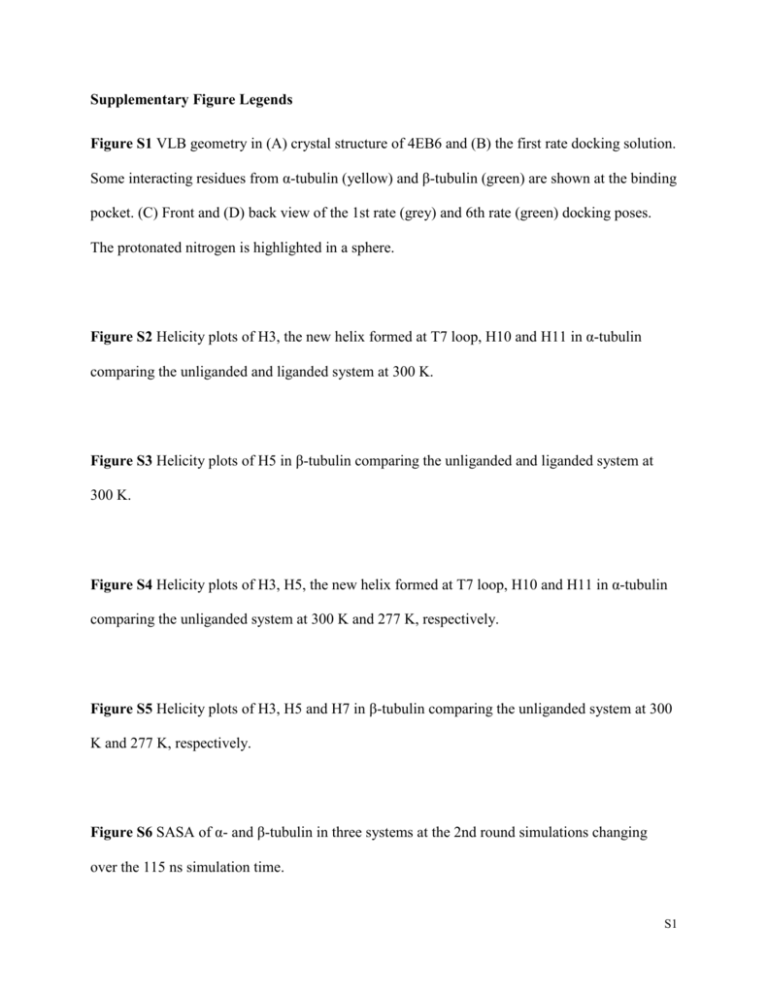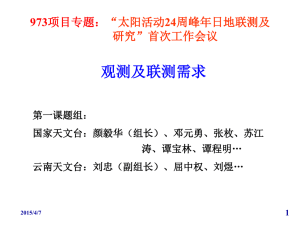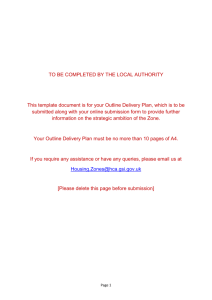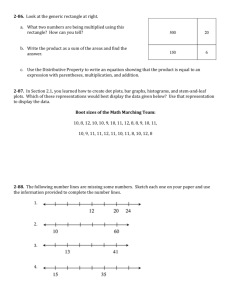prot24793-sup-0014-suppinfo1
advertisement

Supplementary Figure Legends Figure S1 VLB geometry in (A) crystal structure of 4EB6 and (B) the first rate docking solution. Some interacting residues from α-tubulin (yellow) and β-tubulin (green) are shown at the binding pocket. (C) Front and (D) back view of the 1st rate (grey) and 6th rate (green) docking poses. The protonated nitrogen is highlighted in a sphere. Figure S2 Helicity plots of H3, the new helix formed at T7 loop, H10 and H11 in α-tubulin comparing the unliganded and liganded system at 300 K. Figure S3 Helicity plots of H5 in β-tubulin comparing the unliganded and liganded system at 300 K. Figure S4 Helicity plots of H3, H5, the new helix formed at T7 loop, H10 and H11 in α-tubulin comparing the unliganded system at 300 K and 277 K, respectively. Figure S5 Helicity plots of H3, H5 and H7 in β-tubulin comparing the unliganded system at 300 K and 277 K, respectively. Figure S6 SASA of α- and β-tubulin in three systems at the 2nd round simulations changing over the 115 ns simulation time. S1 Figure S7 The curvature of αβ-tubulin heterodimer represented by H7 orientation of the unliganded heterodimer at (A) 300 K, (B) 277 K and of (C) the liganded heterodimer at 300 K from the 2nd round simulations. The angles indicate the average deviation of heterodimers shifting from the curved conformation in the crystal structure. The inset scheme at (C) describes the structure caused by VLB with more bending than the crystal structure. Figure S8 The distance between charged residues contributing to the electrostatic surface. Each panel is a comparison of a pair of charged residues under two different conditions. The dashed line indicates convergence point. Figure S9 Helicity plots of H3, the new helix formed at T7 loop, H10 and H11 in α-tubulin comparing the unliganded and liganded system at 300 K. The left is from the first round simulations and the right is from the second round simulations. (same as below) Figure S10 Helicity plots of H5 in β-tubulin comparing the unliganded and liganded system at 300 K. Figure S11 Helicity plots of H3, the new helix formed at T7 loop and H10 in α-tubulin comparing the unliganded system at 300 K and 277 K, respectively. S2 Figure S12 Helicity plots of H3 and H7 in β-tubulin comparing the unliganded system at 300 K and 277 K, respectively. S3 Supplementary Tables Tables Table S1 The top 10 docking solutions of mono-protonated VLB ranked by FlexX. Score Match Lipophilic Ambiguous (kJ/mol) (kJ/mol) (kJ/mol) (kJ/mol) -8.0814 -13.0764 -13.542 -8.5235 1 2 -6.2647 -14.7242 -11.4641 -9.289 3 -6.1923 -15.6398 -12.7842 -9.3892 4 -5.3067 -15.6806 -13.5578 -9.0258 5 -4.4144 -12.9817 -16.1357 -9.473 -3.7758 -10.6882 -12.59 -7.3485 6 7 -3.4799 -12.7875 -13.0774 -7.8528 8 -3.3683 -15.5418 -9.7845 -8.9348 9 -2.0776 -15.5224 -13.6993 -8.3718 10 -1.9751 -10.7183 -11.3053 -6.2374 Score: total score of the docking solution rank Clash (kJ/mol) 4.8606 7.0126 9.4209 10.7575 11.9761 4.6505 8.0378 8.6928 13.3159 4.0859 RMSD (Å) 6.3851 10.7734 8.6124 8.1732 7.5182 6.3335 8.3967 9.1038 7.4438 8.8255 Match: contribution of the matched interacting groups Lipophilic: contribution of the lipophilic contact area Ambiguous: contribution of the lipophilic-hydrophilic (ambiguous) contact area Clash: contribution of the clash penalty RMSD: RMSD of coordinates from reference coordinates S4 Figures Figure S1 VLB geometry in (A) crystal structure of 4EB6 and (B) the first rate docking solution. Some interacting residues from α-tubulin (yellow) and β-tubulin (green) are shown at the binding pocket. (C) Front and (D) back view of the 1st rate (grey) and 6th rate (green) docking poses. The protonated nitrogen is highlighted in a sphere. S5 Figure S2 Helicity plots of H3, the new helix formed at T7 loop, H10 and H11 in α-tubulin comparing the unliganded and liganded system at 300 K. S6 Figure S3 Helicity plots of H5 in β-tubulin comparing the unliganded and liganded system at 300 K. S7 Figure S4 Helicity plots of H3, H5, the new helix formed at T7 loop, H10 and H11 in α-tubulin comparing the unliganded system at 300 K and 277 K, respectively. S8 Figure S5 Helicity plots of H3, H5 and H7 in β-tubulin comparing the unliganded system at 300 K and 277 K, respectively. S9 Figure S6 SASA of α- and β-tubulin in three systems at the 2nd round simulations changing over the 115 ns simulation time. S10 Figure S7 The curvature of αβ-tubulin heterodimer represented by H7 orientation of the unliganded heterodimer at (A) 300 K, (B) 277 K and of (C) the liganded heterodimer at 300 K from the 2nd round simulations. The angles indicate the average deviation of heterodimers shifting from the curved conformation in the crystal structure. The inset scheme at (C) describes the structure caused by VLB with more bending than the crystal structure. S11 Figure S8 The distance between charged residues contributing to the electrostatic surface. Each panel is a comparison of a pair of charged residues under two different conditions. The dashed line indicates convergence point. S12 S13 S14 Figure S9 Helicity plots of H3, the new helix formed at T7 loop, H10 and H11 in α-tubulin comparing the unliganded and liganded system at 300 K. The left is from the first round simulations and the right is from the second round simulations. (same as below) S15 Figure S10 Helicity plots of H5 in β-tubulin comparing the unliganded and liganded system at 300 K. S16 Figure S11 Helicity plots of H3, the new helix formed at T7 loop and H10 in α-tubulin comparing the unliganded system at 300 K and 277 K, respectively. S17 Figure S12 Helicity plots of H3 and H7 in β-tubulin comparing the unliganded system at 300 K and 277 K, respectively. S18






